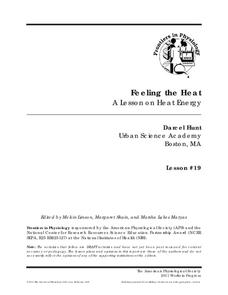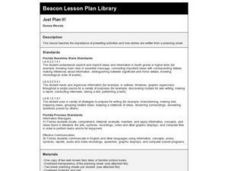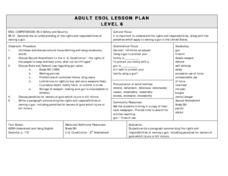American Physiological Society
Hoo Eats Who and What is What in Your Own Backyard?
Bird is the word! Teach life science scholars the importance of our feathered friends and the roles they play in our ecosystem. Using the plan, learners investigate the birds in their areas, determine the biotic and abiotic factors that...
American Physiological Society
Sticky Adaptations A Lesson on Natural Selection
Now you see it, now you don't! The stick bug exhibits the ability to disappear into a wooded environment. Why does this adaptation manifest in some species, but not in others? Life science students explore animal adaptations in nature...
American Physiological Society
Effects of Environment on Enzymes
Much like the tale of Humpty Dumpty, proteins, once altered, will never be the same again. Honors and pre-AP biology classes explore the delicate world of enzymes via a Webquest and lab experiment. The teacher's guide contains all...
American Physiological Society
It’s the Heart of the Matter
Get the class jumping for joy with a fascinating look at matters of the heart. Learners perform physical tasks, collect and analyze heart rate data, and study conditions that affect heart health. Use the action-packed lesson plan to...
American Physiological Society
How Does the Density of a Liquid Affect the Buoyancy of an Object?
Here's a lesson plan that will really float your boat! Introduce physical science scholars to the relationship between buoyancy and density through an assortment of individual and collaborative exercises. Lab groups work together to...
American Physiological Society
Why is Kettle Corn Cooked in Copper Pots?
The kitchen — it's not just for eating anymore! Specific heat is often a difficult concept to grasp, so give it context by relating it to cooking. Learners gain experience in the principles of thermal energy transfer by designing an...
American Physiological Society
Sit On It
How do product designers come up with the variety of things we see in stores and on TV every day? They identify a need, then create something that meets that need. Sounds simple, right? A two-week instructional activity puts seventh...
American Physiological Society
Feeling the Heat
How do the changing seasons affect the homes where we live? This question is at the forefront of engineering and design projects. Challenge your physical science class to step into the role of an architect to build a model home capable...
American Physiological Society
An Inquiry into Alcoholic Fermentation
Introduce life science students to their new "best buds" yeast! Using a wide variety of materials, lab groups design an experiment that illustrates how yeast acquires the resources it needs to undergo cellular respiration. The teacher's...
Curated OER
Digestible Computers
Young scholars examine the pros and cons of 'embedded computing' in the field of medicine. They invent and describe a computer that would be embedded in an individual to improve their education or school and write essays critiquing their...
Curated OER
Discrimination on the Menu
Students study discrimination in the workplace. In this discrimination lesson, students define the term 'fair' and work in groups to find ways all people are alike and different. Students write sentences defining a fair classroom, a fair...
Curated OER
Feed Your Cells
Students examine and research the human digestive system and what happens to the food we eat. They read the article, The Passage of Food, participate in an experiment with crackers, and write a paragraph summarizing the function of the...
Curated OER
A Taste of Blackberries
Fourth graders participate in a shared reading of Doris Buchanan's, A Taste of Blackberries. They read about grief in the loss of a best friend and examine the skills of a responsible family member.
Curated OER
Let's Retell This Story
Fourth graders identify story grammar elements of "The Three Billy Goats Gruff." The elements are recorded on a chart and students use the story grammar elements from the chart to retell the story.
Curated OER
Just Plan It!
Fourth graders practice using a planning sheet for a well-known fairy tale or picture book.
Curated OER
Entrepreneurs and the African-American Dream
Students make a simple graph of labor supply and labor demand in the North and South in the early twentieth century. They conduct research to identify top contemporary African-American entrepreneurs.
Project SMART
Exploring the History of Mathematics
Students research six different mathematicians using Internet resources. They examine the contributions of different cultures, women, and one that made a significant to geometry. They present their research to the class.
Curated OER
Conquests of Land and People in the Pacific Northwest by the Fur Trade
Students examine how the Hudson's Bay Company dominated trade in the Pacific Northwest and compare and contrast how the Hudson's Bay Co. conducted business with competitors, suppliers, and customers to the prominent American fur trade...
Curated OER
Symbol Beneath the Surface in "The Life You Save May Be Your Own"
Young scholars identify the value of symbols in shorts stories and analyze Flannery O'Connor's use of symbolism. In this symbolism lesson, students complete a worksheet about symbols for cars. Young scholars answer questions about...
Curated OER
Globalization and Energy Security
Students take a closer look at energy security and energy independence. In this global issues lesson, students investigate the concept of energy security, consider energy policies and national security issues, and participate in a mock...
Curated OER
Who Are These Chinese People?
High schoolers research the Han, a main Chinese ethnic group and the Hui, another numerous group. They write a paper about the Hui including geography, religion, eating habits, languages, politics and customs.
Curated OER
Yaks, Yurts, and Yogurt: A Look at China's Autonomous Regions
Students are introduced to five Chinese geographical areas. They, in groups, research these areas and develop presentations including information on the physical characteristics, climate, elevation, agriculture and language.
Curated OER
The Right and Responsibility To Bear Arms
Young scholars write a paragraph summarizing the rights and responsibilities of owning a gun, including penalties for owners of guns which injure or kill. This less is designed for students acquiring English.
























